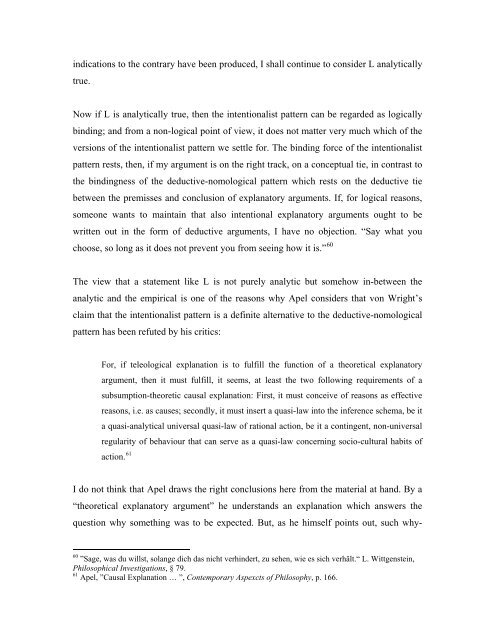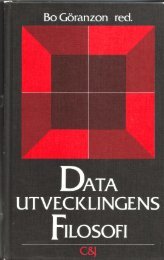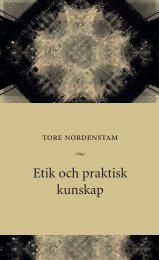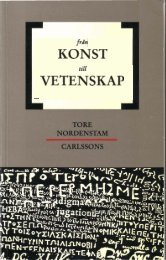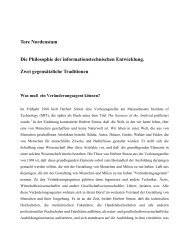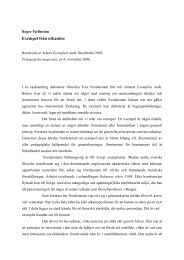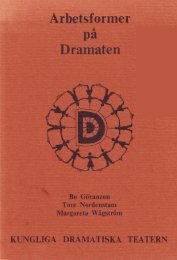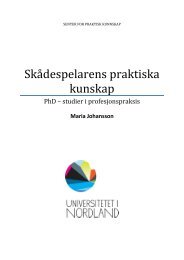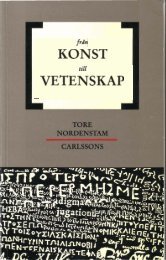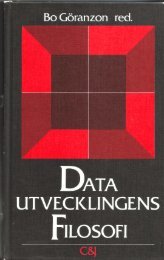tore nordenstam explanation and understanding in the history of art
tore nordenstam explanation and understanding in the history of art
tore nordenstam explanation and understanding in the history of art
You also want an ePaper? Increase the reach of your titles
YUMPU automatically turns print PDFs into web optimized ePapers that Google loves.
<strong>in</strong>dications to <strong>the</strong> contrary have been produced, I shall cont<strong>in</strong>ue to consider L analytically<br />
true.<br />
Now if L is analytically true, <strong>the</strong>n <strong>the</strong> <strong>in</strong>tentionalist pattern can be regarded as logically<br />
b<strong>in</strong>d<strong>in</strong>g; <strong>and</strong> from a non-logical po<strong>in</strong>t <strong>of</strong> view, it does not matter very much which <strong>of</strong> <strong>the</strong><br />
versions <strong>of</strong> <strong>the</strong> <strong>in</strong>tentionalist pattern we settle for. The b<strong>in</strong>d<strong>in</strong>g force <strong>of</strong> <strong>the</strong> <strong>in</strong>tentionalist<br />
pattern rests, <strong>the</strong>n, if my argument is on <strong>the</strong> right track, on a conceptual tie, <strong>in</strong> contrast to<br />
<strong>the</strong> b<strong>in</strong>d<strong>in</strong>gness <strong>of</strong> <strong>the</strong> deductive-nomological pattern which rests on <strong>the</strong> deductive tie<br />
between <strong>the</strong> premisses <strong>and</strong> conclusion <strong>of</strong> explanatory arguments. If, for logical reasons,<br />
someone wants to ma<strong>in</strong>ta<strong>in</strong> that also <strong>in</strong>tentional explanatory arguments ought to be<br />
written out <strong>in</strong> <strong>the</strong> form <strong>of</strong> deductive arguments, I have no objection. “Say what you<br />
choose, so long as it does not prevent you from see<strong>in</strong>g how it is.” 60<br />
The view that a statement like L is not purely analytic but somehow <strong>in</strong>-between <strong>the</strong><br />
analytic <strong>and</strong> <strong>the</strong> empirical is one <strong>of</strong> <strong>the</strong> reasons why Apel considers that von Wright’s<br />
claim that <strong>the</strong> <strong>in</strong>tentionalist pattern is a def<strong>in</strong>ite alternative to <strong>the</strong> deductive-nomological<br />
pattern has been refuted by his critics:<br />
For, if teleological <strong>explanation</strong> is to fulfill <strong>the</strong> function <strong>of</strong> a <strong>the</strong>oretical explanatory<br />
argument, <strong>the</strong>n it must fulfill, it seems, at least <strong>the</strong> two follow<strong>in</strong>g requirements <strong>of</strong> a<br />
subsumption-<strong>the</strong>oretic causal <strong>explanation</strong>: First, it must conceive <strong>of</strong> reasons as effective<br />
reasons, i.e. as causes; secondly, it must <strong>in</strong>sert a quasi-law <strong>in</strong>to <strong>the</strong> <strong>in</strong>ference schema, be it<br />
a quasi-analytical universal quasi-law <strong>of</strong> rational action, be it a cont<strong>in</strong>gent, non-universal<br />
regularity <strong>of</strong> behaviour that can serve as a quasi-law concern<strong>in</strong>g socio-cultural habits <strong>of</strong><br />
action. 61<br />
I do not th<strong>in</strong>k that Apel draws <strong>the</strong> right conclusions here from <strong>the</strong> material at h<strong>and</strong>. By a<br />
“<strong>the</strong>oretical explanatory argument” he underst<strong>and</strong>s an <strong>explanation</strong> which answers <strong>the</strong><br />
question why someth<strong>in</strong>g was to be expected. But, as he himself po<strong>in</strong>ts out, such why-<br />
60<br />
”Sage, was du willst, solange dich das nicht verh<strong>in</strong>dert, zu sehen, wie es sich verhält.“ L. Wittgenste<strong>in</strong>,<br />
Philosophical Investigations, § 79.<br />
61<br />
Apel, ”Causal Explanation … ”, Contemporary Aspexcts <strong>of</strong> Philosophy, p. 166.


